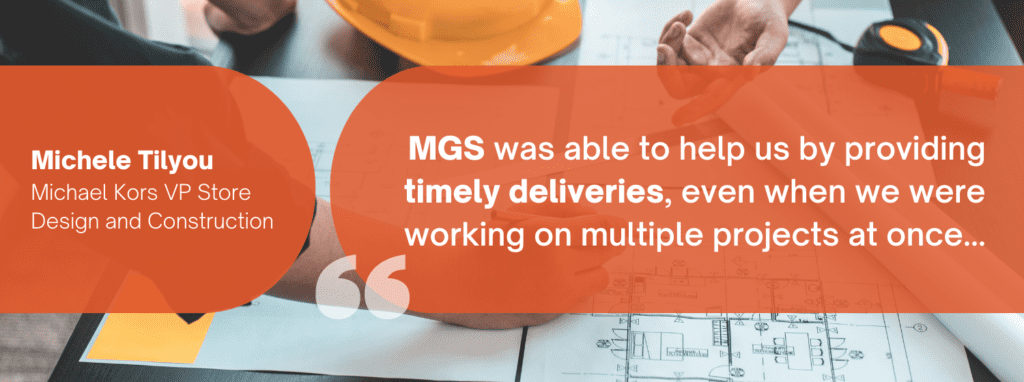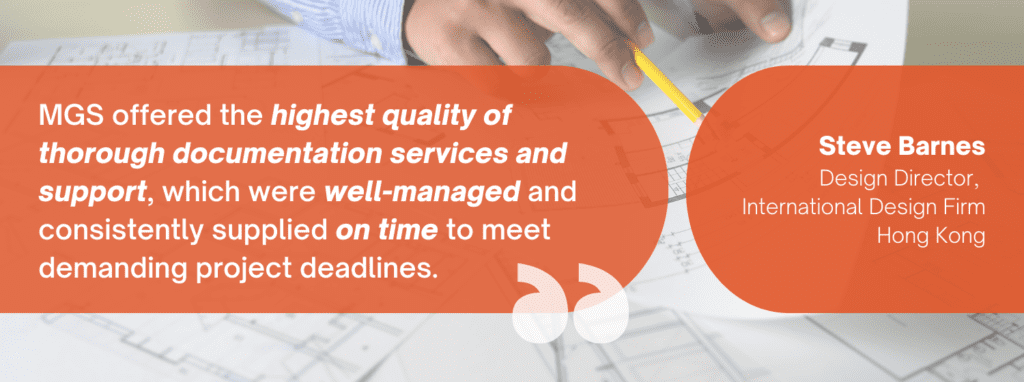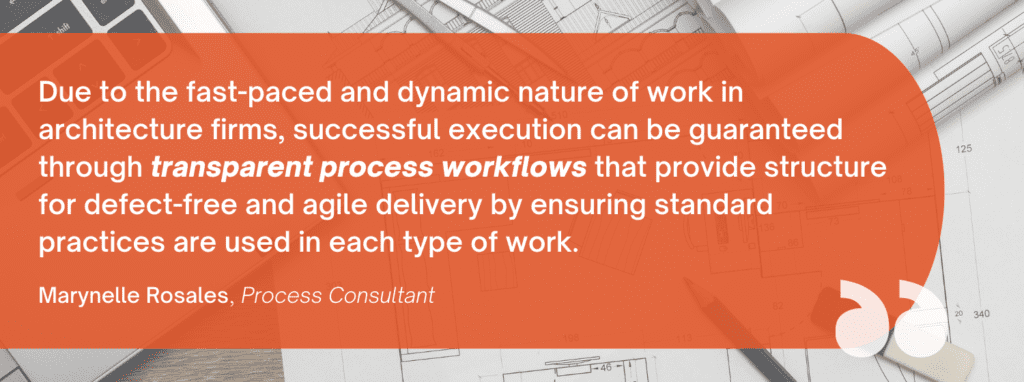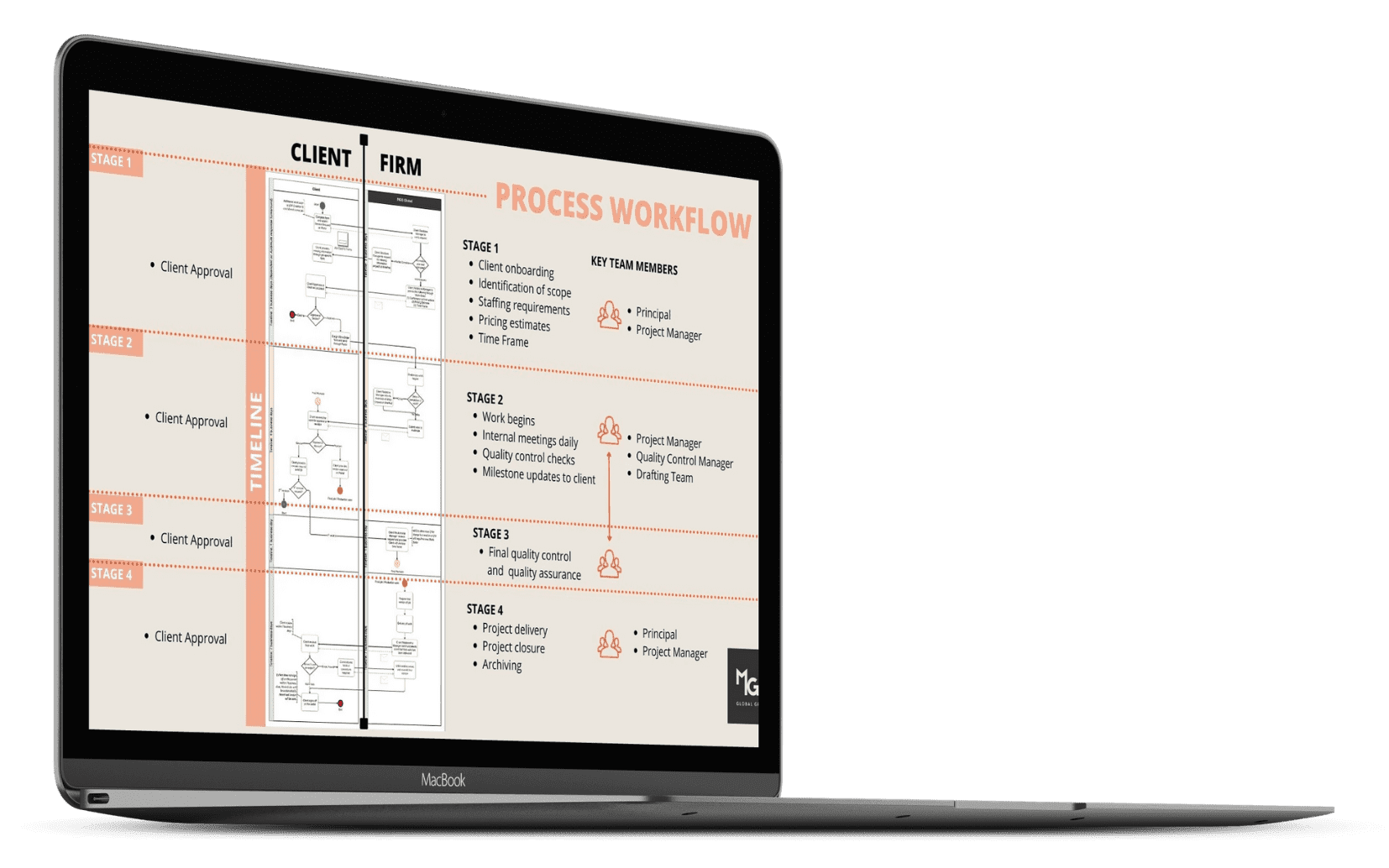On time and on budget project delivery without losing quality
- 7 min read
- July 27, 2022
Architecture Firms are Experiencing Project Surges
The pandemic has impacted nearly every firm on the planet, yet consequences vary greatly across nations and industries. Most of the affected enterprises are in the hospitality industry, but ironically enough, hotel construction, multi-family housing, and quick-service restaurants flourished after the COVID-19 initial surges.
The unexpected upturn in these sectors also translated to growth for the architectural industry. More construction projects were generated for quick-service restaurants and multi-family housing.
Due to the surge of projects, architecture and design firms struggle to complete projects on time and on budget. A majority of them also face financial challenges as early as the drafting phase due to insufficient project planning and insufficient staffing.

Almost 50% of the architecture fees for the design phase are spent on design development and construction documents. Most firms lose revenue at this stage because of tight deadlines that result in rushed and poor-quality output. This leads to unhappy clients especially because they are asked to pay additional fees.
However, this does not have to be the case. By sharing our experiences, we’ll show you how to manage this situation.
Architects are not trained to run a business
Most architects lack the skills and training necessary to manage and operate their firms because they are taught to concentrate only on design. Basic project management concepts, such as creating workflows, aren’t practiced. This makes it difficult for them to achieve and sustain profitability.
To meet multiple deadlines in a timely and cost-effective manner, it is vital to properly understand what and how to plan as well as streamline tasks to make them more efficient.

Knowing who you are and what you have to offer makes all the difference in deciding how to plan for the long term.
Ask yourself these three questions:
- What types of projects does your firm handle?
Design-driven? Commercial? Residential? Rollouts?
- What is your firm size and expected growth?
A small firm of under 10 people or a large firm of over 50?
- Are you a medium-sized firm?
Do you have 10-75 employees? Do you compete with large and small-sized firms?
These questions will help you see where you are now and where you want to go in the future. This is particularly useful for resource allocation and staff planning.
Now, let’s talk about how we put these things into practice through our experiences. We’ll go over two major projects and how we coped with work-related challenges while being profitable.
EXPERIENCE 1: High-volume Rollout for a Luxury Retail Firm
We augmented the staffing needs for a luxury retail client that needed drafting support. Our client needed to expand quickly (50 to 100 new locations per month) and its in-house team couldn’t keep up and produce that many drawing sets each month. This is where our team at MGS Global came in and helped them with construction document drawings.
We took the following actions:
Action 1: Hire the Right People and Manage their Expectations
It goes without saying that when employing new staff, we look for qualified individuals and place the utmost importance on their skill set. Hiring the right people, however, looks beyond qualifications and matches the candidates to the company’s culture. We were particular about this when we decided to get more people on board.
In this project, we hired drafters, not junior architects to do repetitive drafting work. Hiring a junior architect or designer to do drafting work only leads to employee dissatisfaction. Generally, no architect or designer would like to be pigeonholed into only drafting work. It is best to set realistic expectations for new hires and let them know what kind of work is expected of them.
On top of that, we prioritized the importance of onboarding. With the Great Resignation, it was more difficult to find employees. However, by investing time and energy in finding the right person and giving them a successful onboarding experience, you increase the likelihood that 80% of your staff will stay with you.
Keeping the onboarding tip in mind, we hired individuals that are not only qualified but also match the company culture and can fulfill the tasks we require.
Action 2: Evaluate your Processes
There is no one-size-fits-all formula for accomplishing a project. In this case, the new hires weren’t knowledgeable about the project, so we had to assess previous procedures and adjust them to allow us to capitalize on their skills.
To do this, we used an assembly line approach and reorganized each employee’s work, leaving just one core task for each person. In this project, one drafter worked solely on elevations, another on title blocks, and a third on the Reflected Ceiling Plan.
Following this system resulted in:
- An increase in output quality and reduction of errors to almost zero
- Less training time for new staff as they only needed to learn one task
- Increased work output from 50 stores to 100 stores per month
Providing checklists and project progress spreadsheets to track the team’s development was also beneficial to achieving a seamless operation. Creating client progress reports assisted us in determining what to prioritize and what work needed to be completed first.
Action 3: Get an Operations Manager to run day-to-day operations
Ensuring a smooth process is vital in getting the work done. When a project requires a large volume of work, such as this one, having someone supervise day-to-day client deliveries is critical.
Being a creative myself, I was first apprehensive about hiring an Operations Manager. I naively assumed that I could manage everything by myself. Additionally, I was unsure if I could afford an Operations Manager to work full-time. But having worked in this field long enough, I’ve learned that managing my firm’s daily operations is no longer my responsibility as CEO.
Consequently, hiring an Operations Manager to monitor tasks, organize workflow, and take note of deadlines is an essential recipe for meeting goals and keeping the process efficient. It assisted us in preventing missed deadlines and keeping everyone on track. This was one of the smartest business decisions I made for the company.
Action 4: Have a Network of Subcontractors and Outsourced Drafting Partners
Let’s face it: we can’t handle everything all at once. No matter the size of a firm, there are instances when projects are simply too large for us to handle within a short period of time.
Take this project, for example, we provided supplemental help to our client who couldn’t meet the required number of projects expected from them in a month. What do you think would happen if they didn’t reach out for assistance?
This underlines the need for putting together a network of subcontractors and outsourced drafting partners ahead of time to help you complete a project on schedule and within budget.
Partnering with vendors like MGS makes it easy to handle project spikes and improves the efficiency and smoothness of your operations whilst allowing your internal team to focus on their core activities. You can accomplish all this and more while maintaining quality and saving money.

As an advocate of work-life balance, understanding delegation and knowing when to seek assistance are the driving forces behind what I do and why MGS was founded. Our mission is to establish ourselves as a leading drafting support provider and help firm owners grow while maintaining a healthy work-life balance.
EXPERIENCE 2: Complex Multi-Tiered Retail Project
Knowing whether to accept a great opportunity is critical in a highly-competitive field like architecture. However, understanding when and who to hire to complete the work is equally important.
We worked on a 300,000-square-foot hotel and casino in Macau with a world-renowned design director on this project. Because this was his largest endeavor yet, he decided to bring us on for drafting support.
This presented a number of challenges:
- A large amount of work that would require a huge team
- Tight deadlines
- Not enough people in his existing team
- Working with clients and collaborators in two separate time zones.
This is how we made it work:
Solution 1: Provide adequate staffing at the right time
We knew that our client needed a huge support staff but we decided to give provide only 2 senior project managers to support the design director throughout the whole design development process. For a huge project like this, you might start to wonder why we only assigned two?
The answer is simple: we wanted these two senior staff to know everything about the project and the key is to start off with a small team. Our client worked closely with our two seniors and was able to delegate high-level tasks to them while keeping initial staffing costs low. With this, the client was able to establish a relationship with our team, and our team won his trust.
In cases like these, you must be very careful when adding new team members. A seamless and drama-free transition is always the better option, so make sure you don’t overstaff and that every team member can contribute. In short: avoid having too many chefs in the kitchen.

Solution 2: Staff on an as-needed basis
We had two people working for our client for the first six months of the DD phase, but when we got to the construction document phase, we hired three additional people under our project managers.
We did this to simplify the process and ensure that it is always error-free. These extra individuals are designated to one task under each project manager, ensuring that all necessary procedures are covered. In year two, the crew had grown by another two members, making them four in total. By this point, our client had more work to sustain and justify the hiring of the two new workers.
It’s also crucial to remember that you don’t have to recruit more people at once— instead, hire only the people you need now and expand as needs and demands evolve. This way, you can keep your employees rather than having to terminate them when they are no longer needed.
Solution 3: Communication is Key
When effective communication is established, teamwork becomes much simpler. Getting the correct information to the right person at the right time is the key. In this project, however, time was a crucial factor that we needed to consider. Having three teams in two different time zones inevitably made it more challenging to communicate normally.
We addressed this by ensuring that each team member provided timely updates. We promptly set up a meeting with the client when queries arise or specific instructions needed to be clarified, but we first make sure that the schedule is convenient for everyone. We also hold weekly team meetings to ensure that our members are constantly on the same page.
Furthermore, we learned not to take a 10-minute clarification call for granted as it helped us steer clear of costly errors down the road. Selecting the appropriate and most convenient platforms such as Slack, Zoom, and Google Meet allowed us to hold productive meetings as it offers features like chat, video, real-time screen sharing, and document sharing.

Our communication protocol is also one of the major components that helped us weather the storm. In MGS, our onboarding process involves an orientation of our communication protocol which has consistently helped us in preventing errors or minimizing them. This helped us set up a system of communication so that we know exactly who to talk to and ensure that we are understood.
Mistakes are expensive— which is why it is crucial to keep in mind that errors should always be avoided when working on a big project. These blunders frequently result from miscommunication, which feeds into further faults in other areas. Indeed, putting communication on top of everything can greatly affect a team’s productivity and teamwork in the long run.
Keys to Success
Many firm owners, particularly small firms, have an inclination to micromanage and control their operations, making sure they are involved in every step. Though this sounds normal since “hands-on” seems to be the easiest path to growth, it could also be the quickest way to spiral down.
While the tips we specified above have shown to be effective in offering on-time and on-budget solutions to high-demand project challenges, don’t forget to look into these three factors as well for best results:
1. Leadership– Have a clear vision of your company and let it guide you. In order to encourage everyone to hop in, develop a set of values that are shared by all members that’ll serve as your driving force.

2. Processes and procedures– Establish clear protocols and procedures for your firm so that your employees understand what they are expected to do. Employee satisfaction leads to lower turnover, which leads to increased profitability.

3. Collaboration– Create a culture of collaboration with other firm owners and vendors so you can pool resources from larger firms to help you expand. This prevents employee burnout and missed deadlines for your clients.
Food for thought
Now that you have learned proven effective tips on how to manage your firms and keep projects on track while being profitable, I’d like you to reflect on these questions:
- Are you ready to put your systems in place for growth?
- Do you recognize that you need to hire specific roles, upgrade technology, and reorganize your office structure to allow for expansion?
- Are you ready to create your own process workflow?

Was this helpful? Give a thumbs up or post a comment.
For more of our blogs, check out https://mgsglobalgroup.com/blog/.
MGS Global Group is here to help if you require any more assistance. Get in touch with us for all your drafting needs.
Connect with us!



